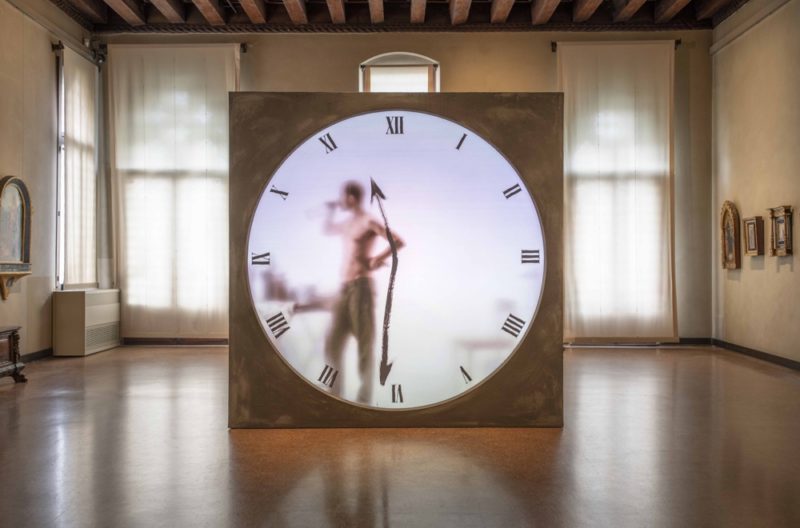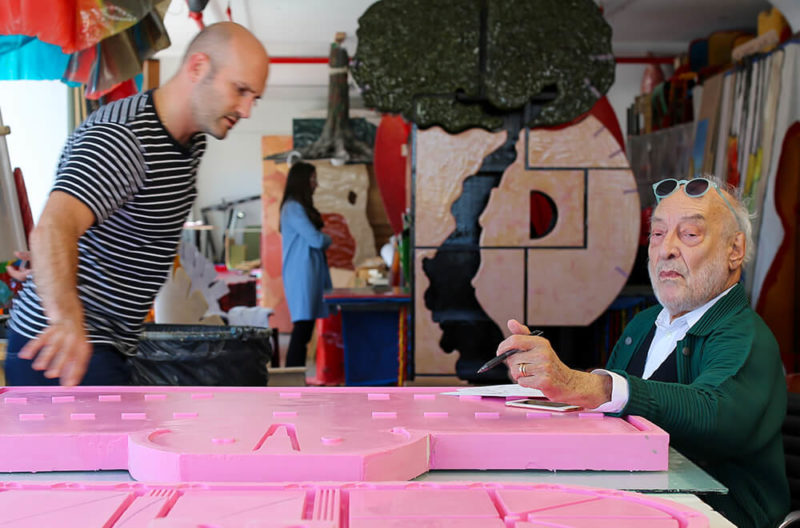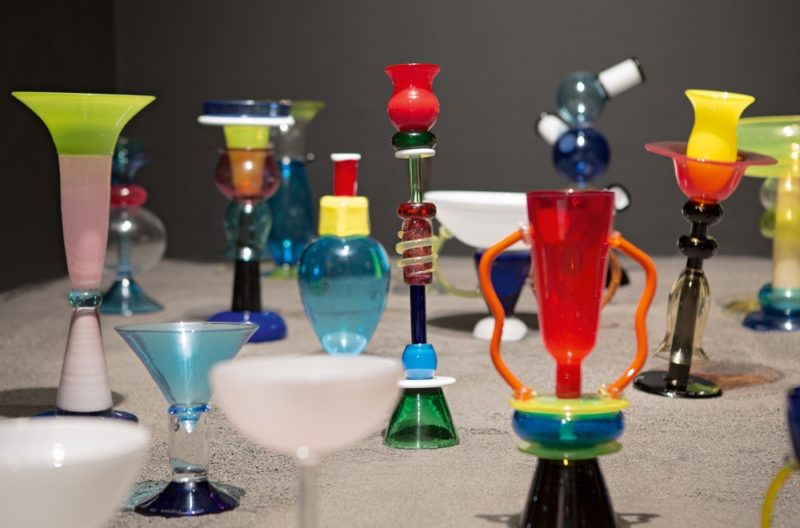Vincenzo De Cotiis
For his first exhibition at Carpenters Workshop Gallery in Paris, Vincenzo De Cotiis has created a new collection of shimmering works inspired by Japan and the theme of iridescence.
Carpenters Workshop Gallery, Paris
16th October – 21st December 2019
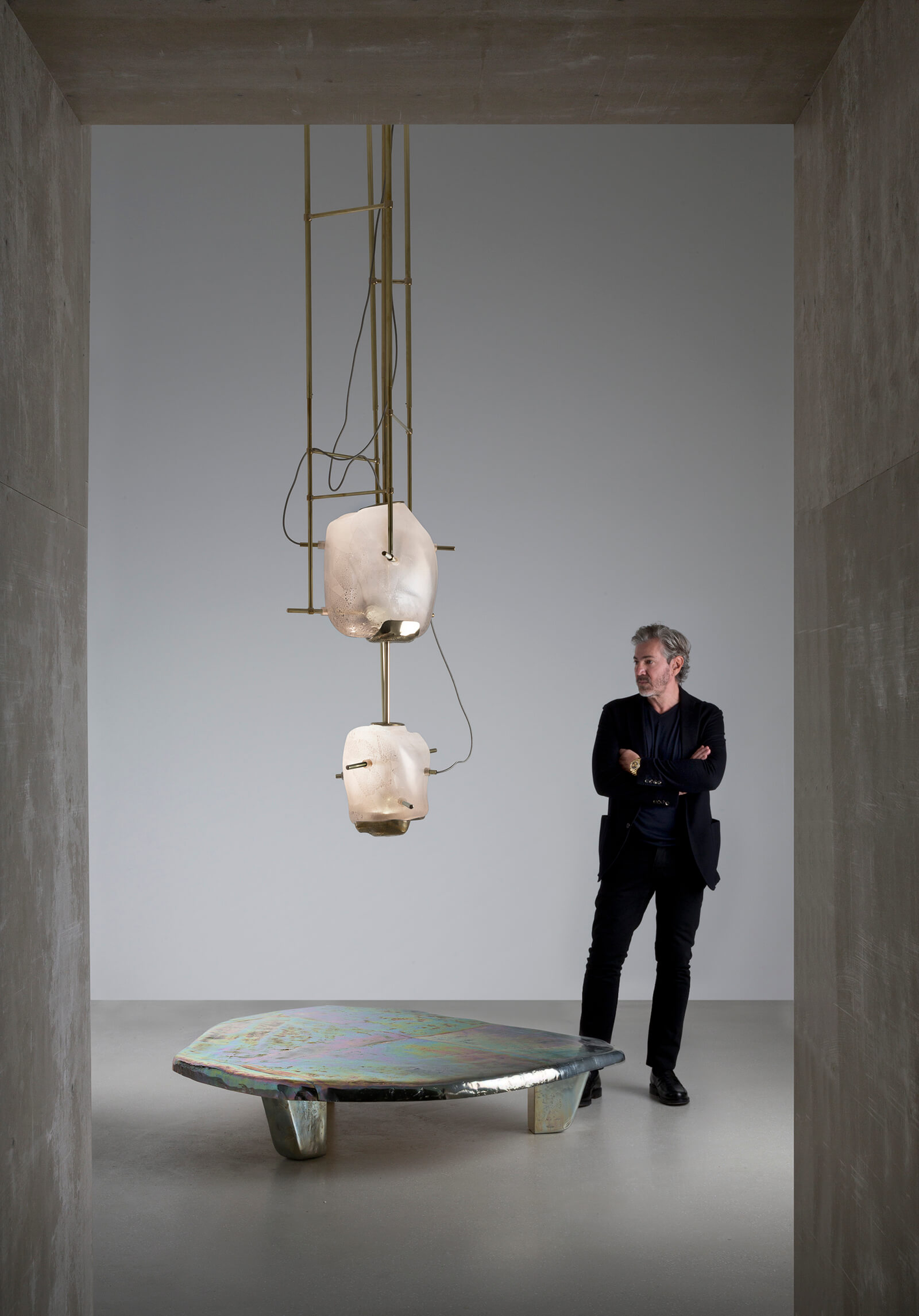
Vincenzo de Cotiis with ‘DC1909B’ chandelier, 2019 and ‘DC1901’ coffee table, 2019
COURTESY: Carpenters Workshop Gallery
VINCENZO DE COTIIS, the Italian architect and designer, who founded his studio in Milan in 1997, is known for his excellence at juxtaposing materials. For ‘Éternel’, De Cotiis has made several pieces combining cast aluminium with brass, treating the surface pictorially. The golden-and-silvery textures reveal themselves to have a rainbow-hued patina that shifts in the light. A dining table is layered with Murano glass and resin to sublime effect; a coffee table where Brazilian granite merges with pools of aluminium evokes a Japanese landscape; blown-glass lamps, with inner silver-leaf patterns, are suspended from Brutalist-inspired brass structures.
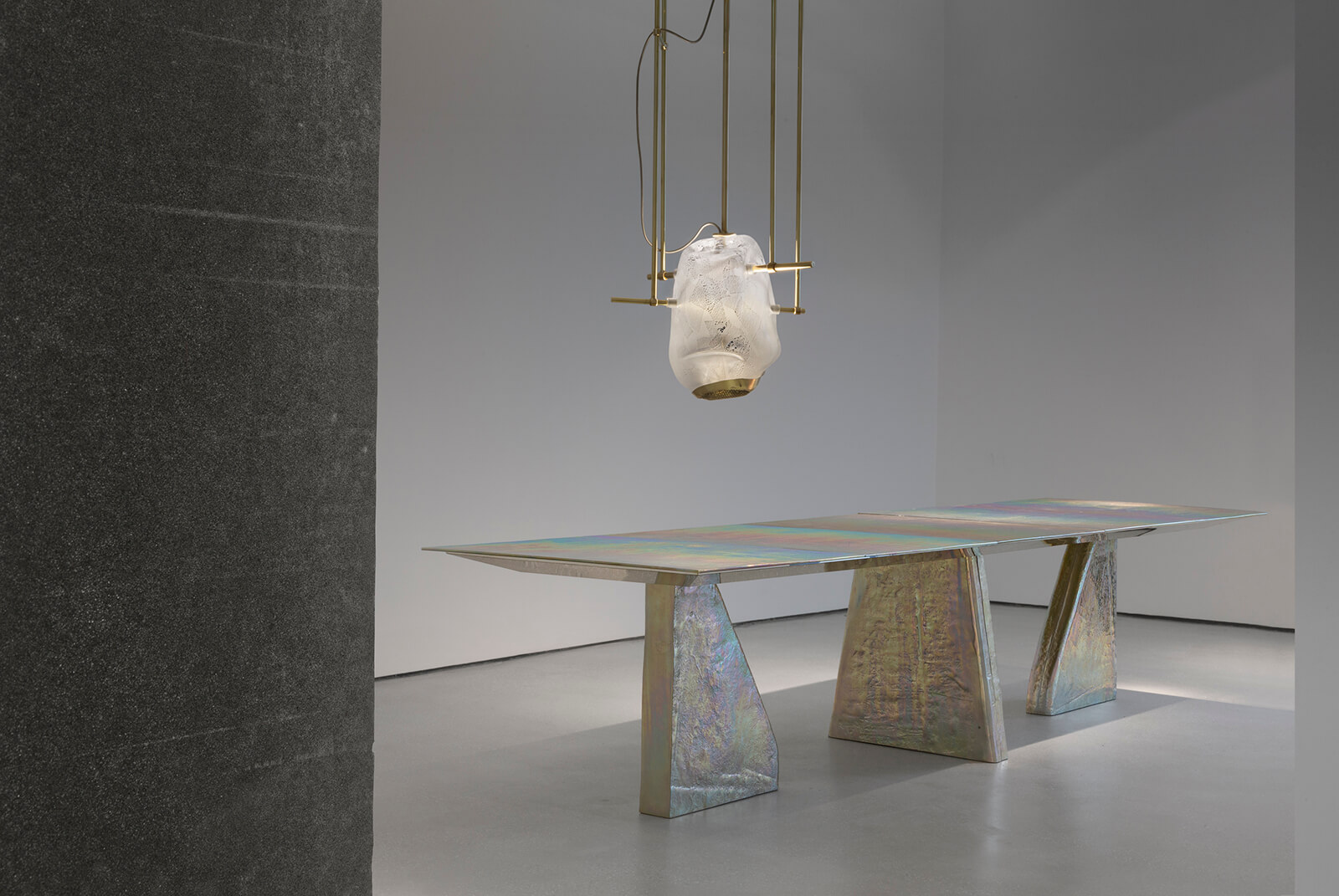
Vincenzo de Cotiis, ‘DC1908’ dining table, 2019 and ‘DC1909A’ chandelier, 2019
COURTESY: Carpenters Workshop Gallery
De Cotiis, 61, has also overlaid an arch and the walls of the second half of the gallery with taupe panels, speckled with white – an architectural intervention that the gallery intends to retain after the exhibition.
What ideas and memories of Japan inspired the pieces in ‘Éternel’
I visited Japan for the first time 20 years ago, and designed a fashion showroom in Tokyo around 16 years ago. This collection was born from emotions that I’ve felt there, and my memories of lanterns and minimal forms of architecture that I’ve sought to transcribe in contemporary works. I wanted to convey the iridescent landscape of Japanese cherry blossoms, how the colour isn’t unique but moves from blue to pink and green.
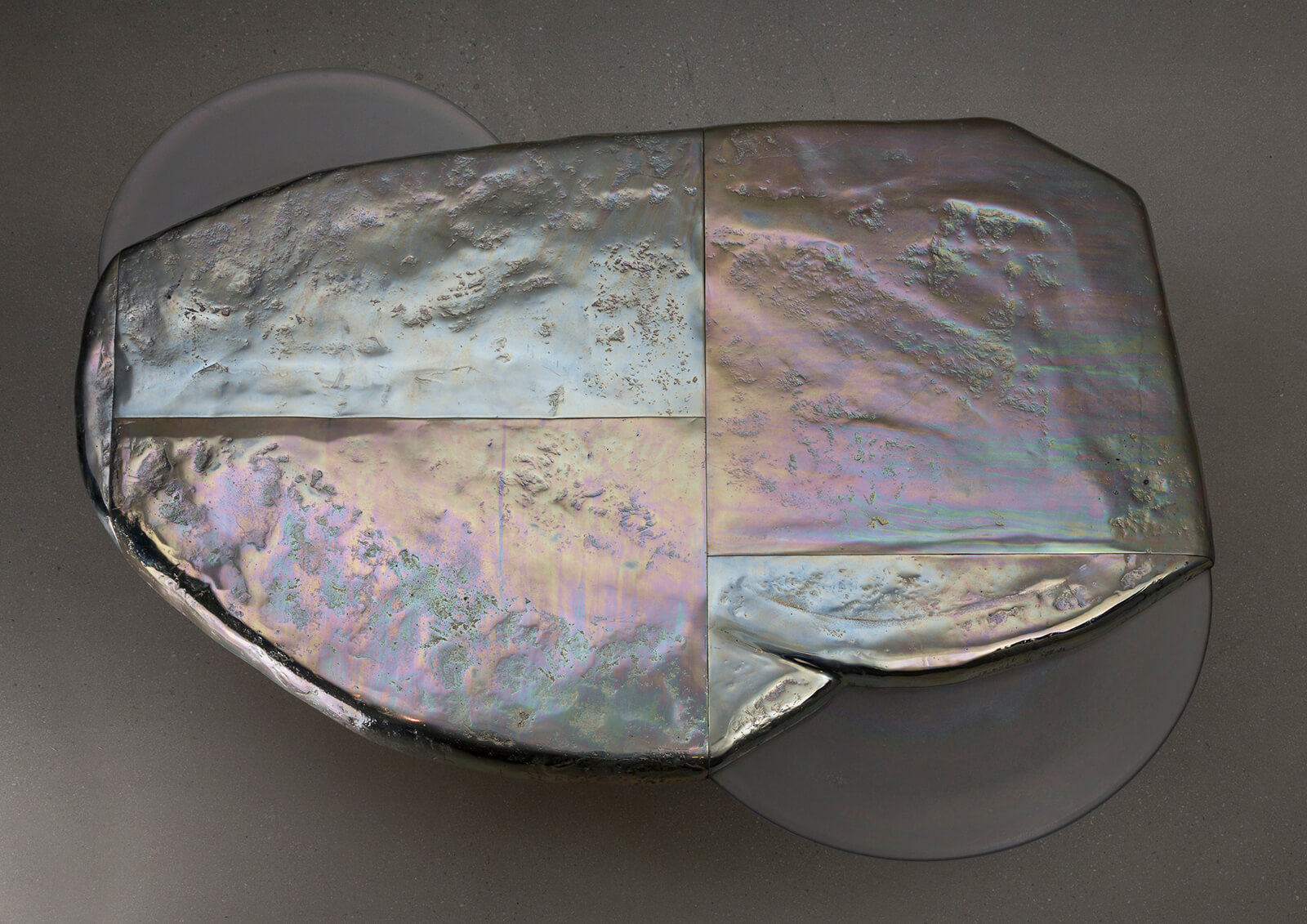
Vincenzo de Cotiis, ‘DC1902’ coffee table, 2019
COURTESY: Carpenters Workshop Gallery
Reflections are another important element as I saw many reflections, not just in the landscape, but in the cities where one has constant reflections from technology. And I tried to represent Japanese ceramics by manually colouring recycled fibreglass with those nuances, and depicting it like Japanese painting.
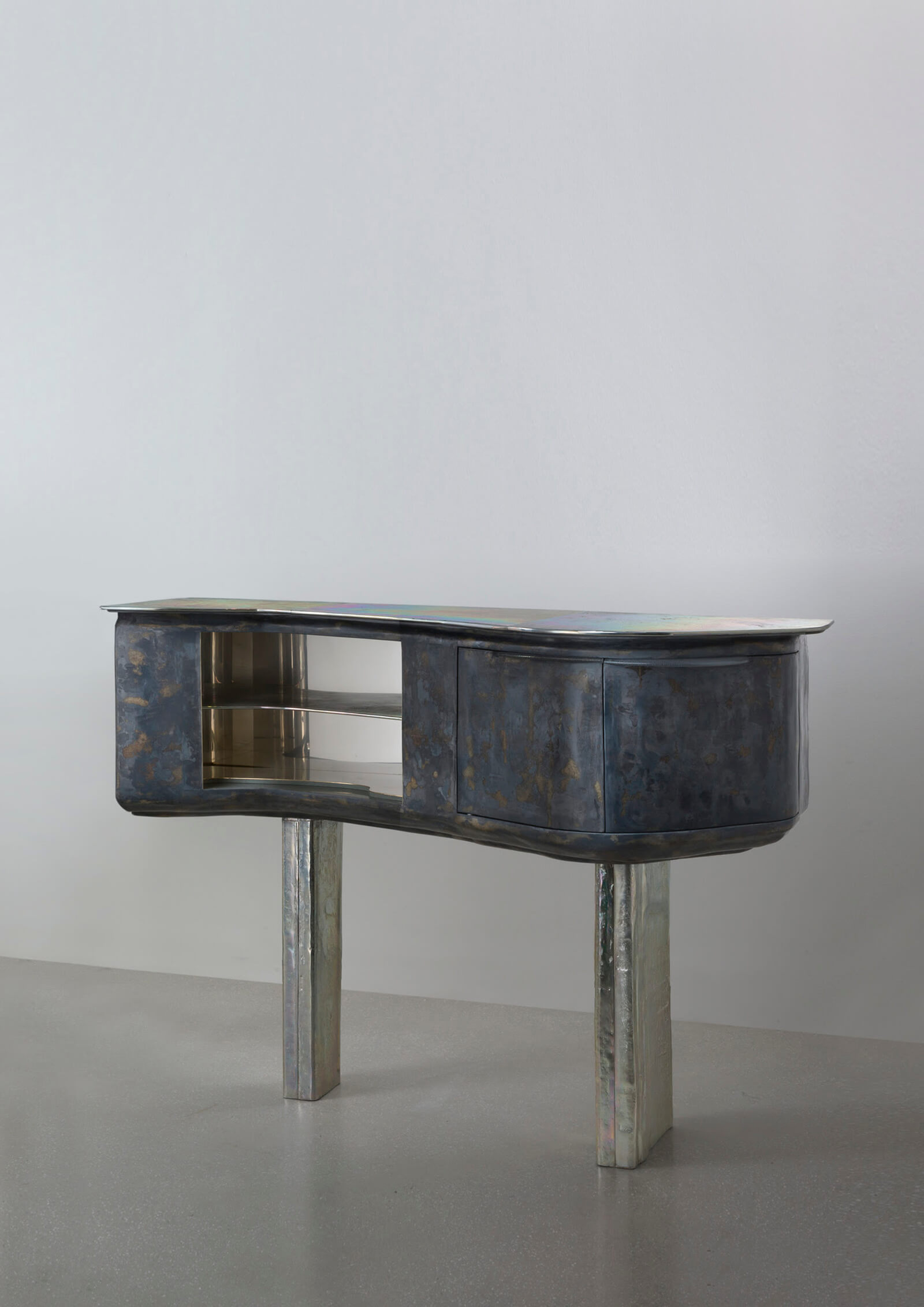
Vincenzo de Cotiis, ‘DC 1912B’ cabinet, 2019
COURTESY: Carpenters Workshop Gallery
Many of the pieces juxtapose different materials. What are you seeking through these juxtapositions?
Combining different materials, and smooth surfaces with rough surfaces, is something I love doing because they have different tensions, structures and materiality. Recycled fibreglass [from shipyards] has been important in my work since I started using it 30 years ago. What’s constant in my research is that there’s always [the passage of] time underneath these materials. It’s like a wart on the face – I’ve always been more attracted to a lined face than a completely unlined one.
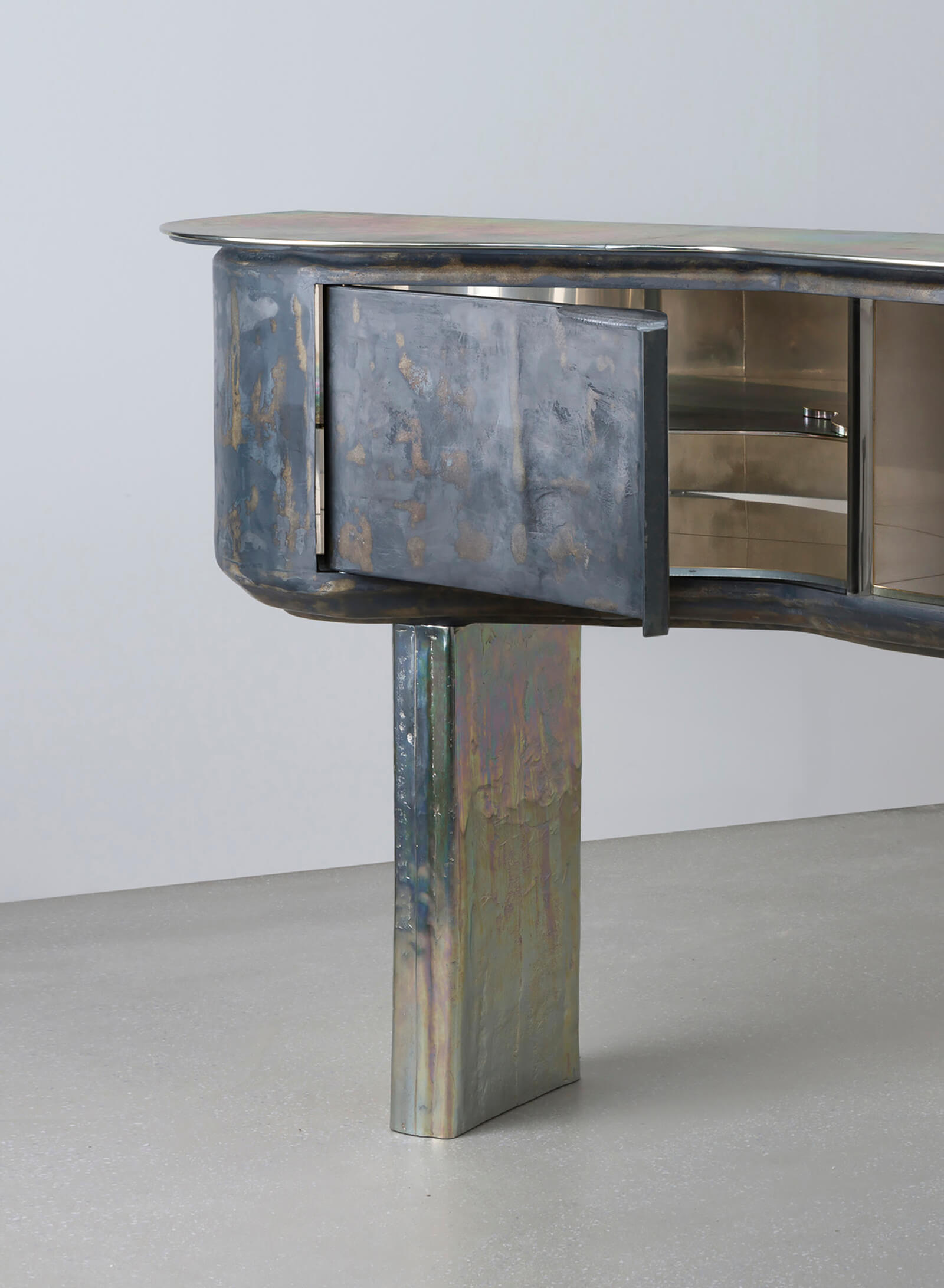
Vincenzo de Cotiis, ‘DC1912A’ cabinet, 2019
COURTESY: Carpenters Workshop Gallery
Thinking about how time has passed through materials informs my initial design idea. Then comes the more experimental side about combining materials – like in the sinuously formed cabinet that we call the ‘Dragon Cabinet’. The front is treated like a Japanese cherry blossom with layers of hand-painted colours. But inside, it’s almost like a timeless oriental, minimal architecture that is luxurious, more precise and detailed.
One of your coffee tables combining cast aluminium with Brazilian stone containing amethyst, evokes a Japanese landscape. What can you tell us about it?
I bought this Brazilian stone, which had been imported into Italy, five years ago – the quarry has now closed. I’ve always loved buying these materials because I know that I can use them in the future. This natural-looking stone with obvious metaphysical elements was perfect for this project because I wanted to represent a typical Japanese landscape. I worked on the surface, rendering it more morbid, and we oxidised and treated it to achieve this green colouring. I also thought of using iridescent cast aluminium because I like that it’s reflective, almost like water, and painted it.
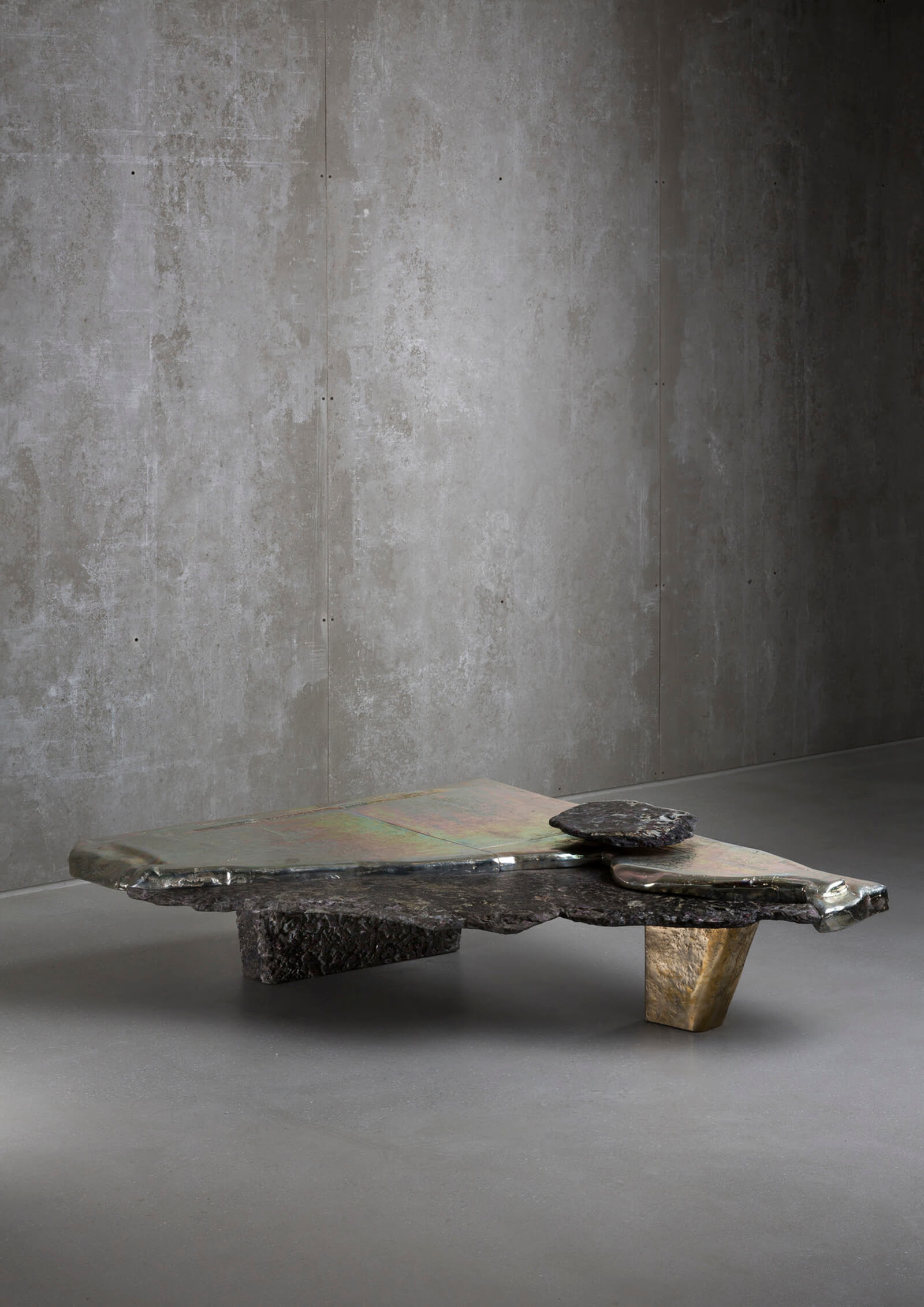
Vincenzo de Cotiis, ‘DC1914’ coffee table, 2019
COURTESY: Carpenters Workshop Gallery
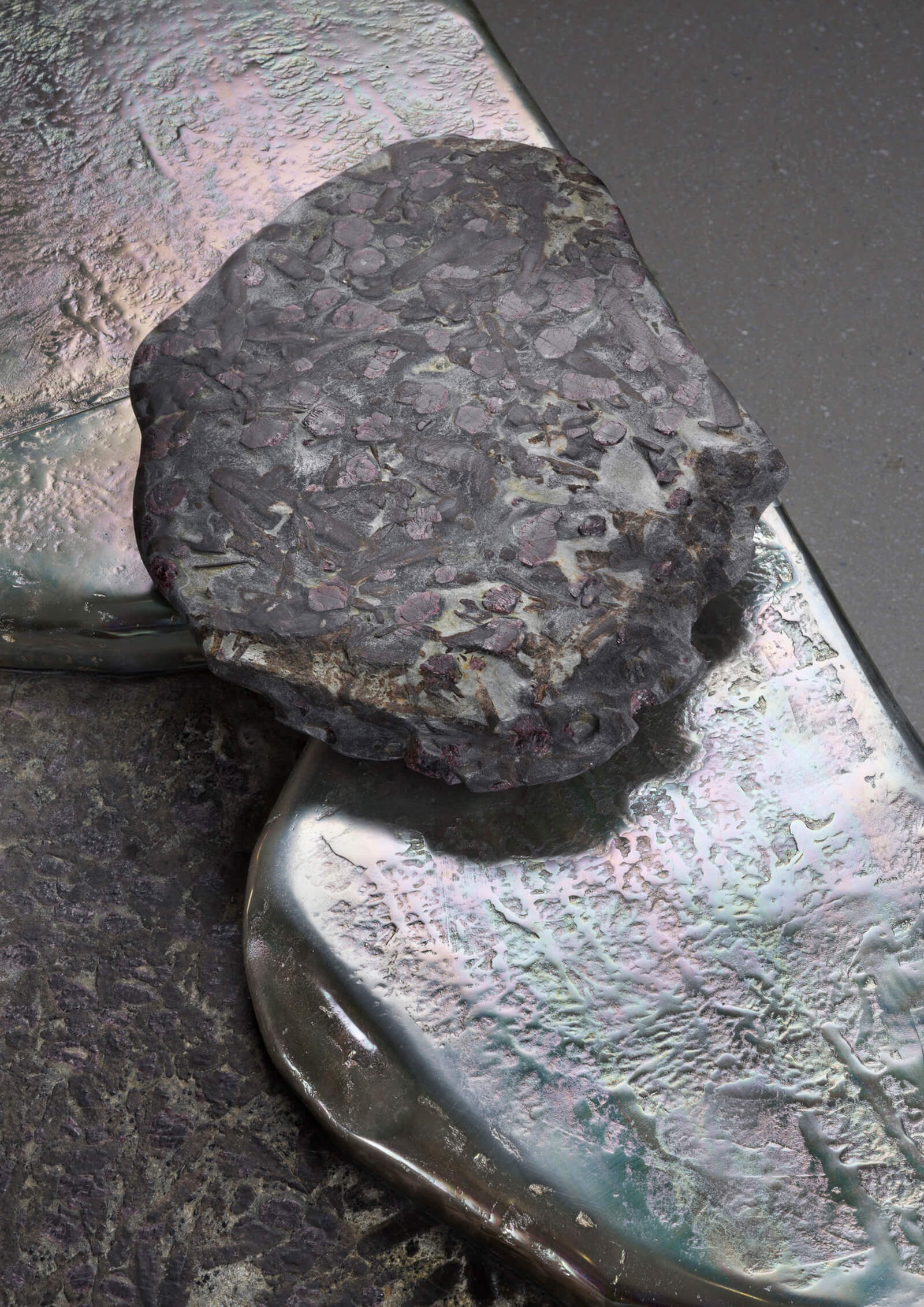
Vincenzo de Cotiis, ‘DC1914’ coffee table, 2019 (detail)
COURTESY: Carpenters Workshop Gallery
I also used the Brazilian stone for the side table whose form is inspired by how a Bonsai tree doesn’t grow in a natural way, but becomes architectural. After hand-sculpting the two pieces of stone, I inserted a block of aluminium in between them, fusing it with the sculpted forms.
Your attraction to recycled materials brings to mind the Italian movement Arte Povera from the late 1960s and 70s, even though your works are more luxurious. What can you tell us about your historical references and philosophy?
With each material, I like to give a new life, like in Arte Povera. The quite rough art forms of Arte Povera and Brutalist architecture belong to my DNA. When I started, I wasn’t influenced by the Memphis group but by avant-garde Japanese architecture. The Italian architect Carlo Scarpa and the American artists Donald Judd and Frank Stella are also among those that have influenced me. But I’ve taken a much more artistic path than Scarpa or Gio Ponti.
My philosophy has always been to go slightly against function, which is something that’s very important in Italian industrial design. I’ve always followed my own path, going towards art more than design, making unique pieces through artisanal processes. I’m very happy with this collection because it represents a new step in my work and how I’ve resolved to release myself from tradition.

Exhibition view, Vincenzo de Cotiis ‘Éternel’
COURTESY: Carpenters Workshop Gallery
“My philosophy has always been to go slightly against function, which is something that’s very important in Italian industrial design”
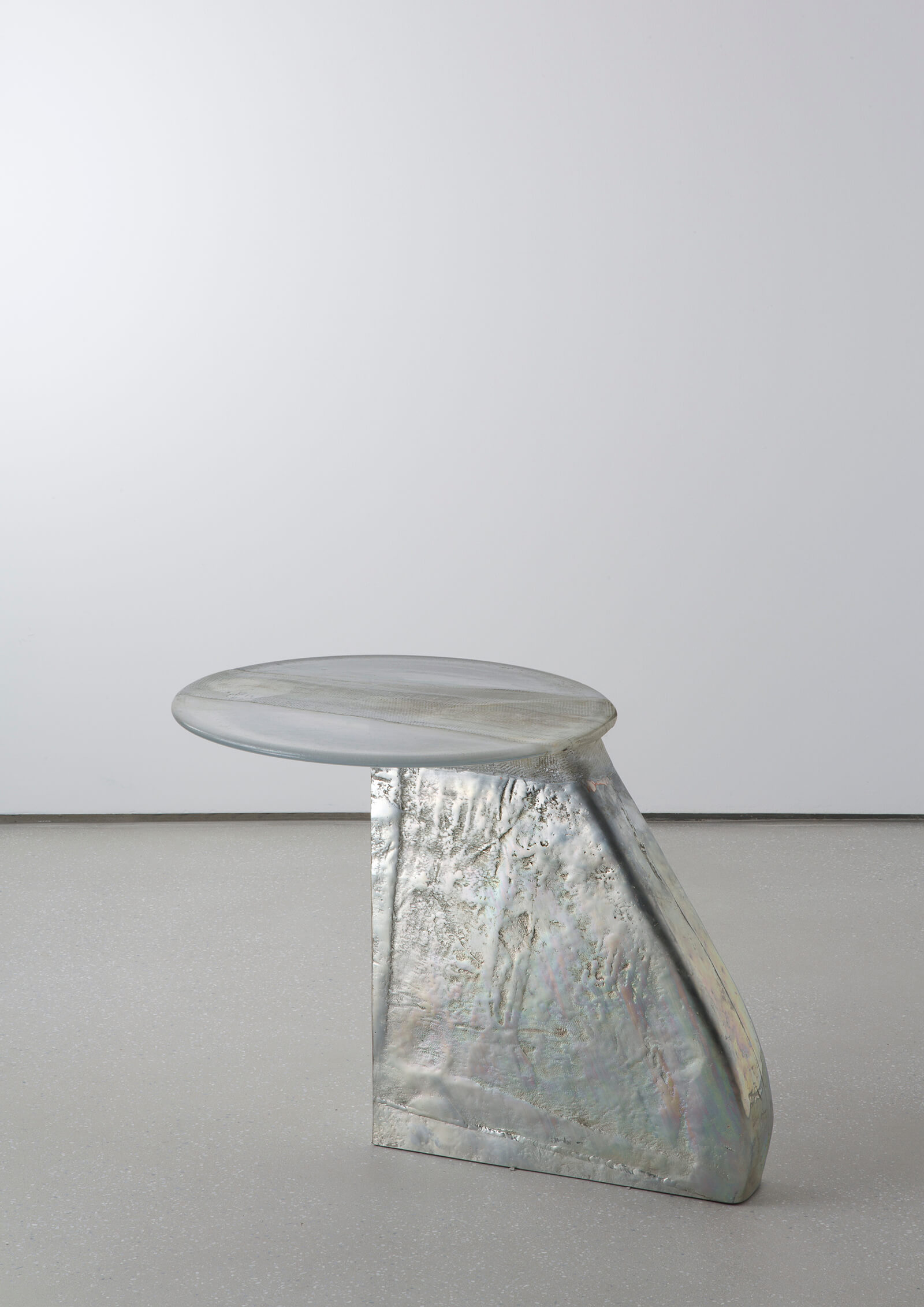
Vincenzo de Cotiis, ‘DC1903’ side table, 2019
COURTESY: Carpenters Workshop Gallery
“I’ve always followed my own path, going towards art more than design, making unique pieces through artisanal processes”
What ideas would you like to explore in your next collection?
It will be an evolution from this. I still want to work with recycled materials, probably wood – a material that I used 20 years ago but have never used since.
Do you think designers have a responsibility to use recycled materials?
Not in my opinion but if it’s possible, absolutely. We, artists, can do so but in a limited way. I think it’s manufacturers that need to work with recycled materials – it’s a responsibility on a higher level of society.
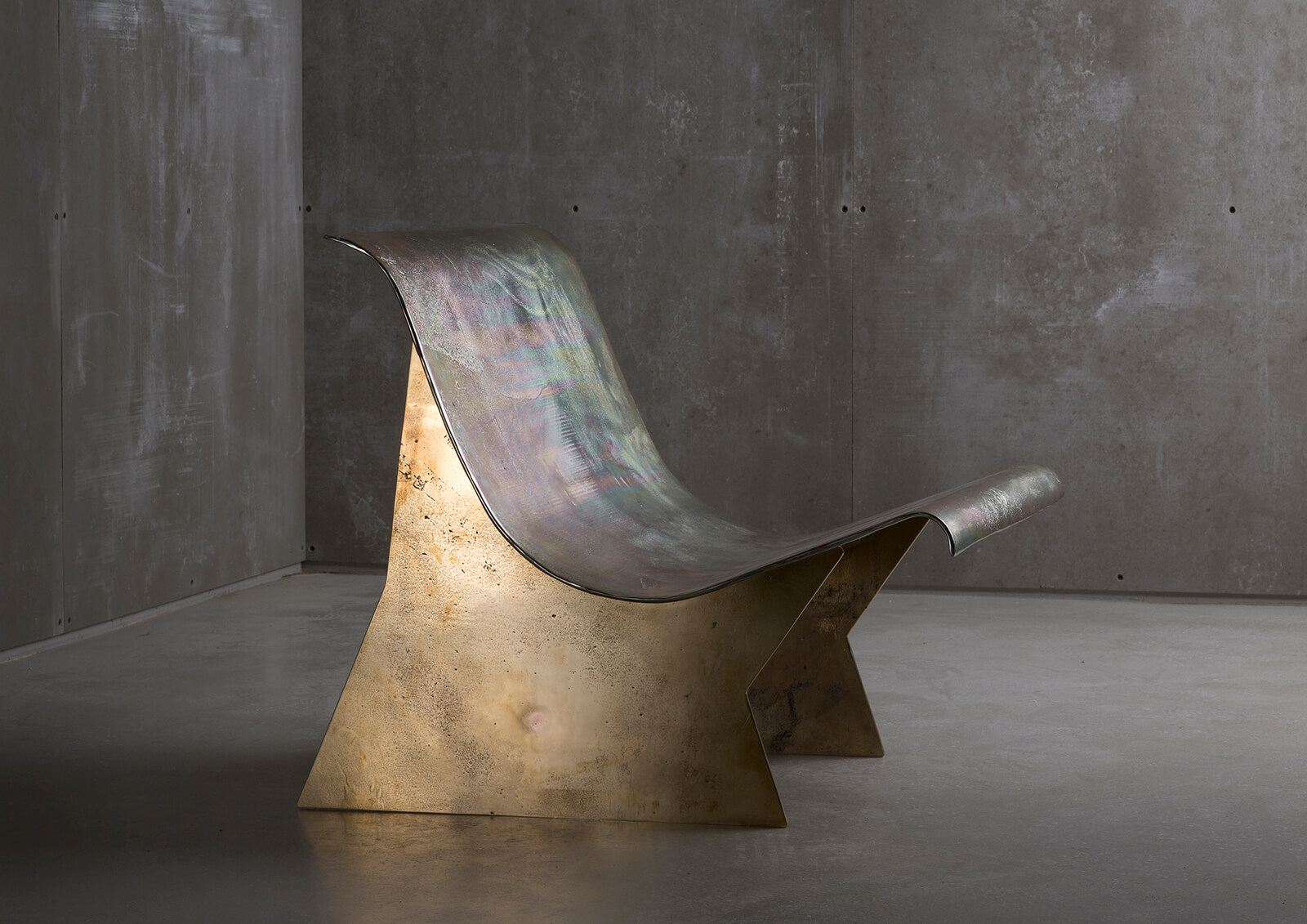
Vincenzo de Cotiis, ‘DC1919’ lounge chair, 2019
COURTESY: Carpenters Workshop Gallery
Vincenzo De Cotiis
COURTESY: Carpenters Workshop Gallery
Carpenters Workshop Gallery – Innovative art and design galleries in London, Paris, New York and San Francisco.
Vincenzo de Cotiis: Works is published by Rizzoli.




